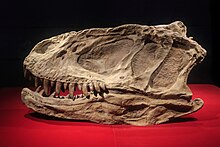Metriacanthosauridae
Stratigrafický výskyt: Střední jura až spodní křída, asi před 176 až 135 miliony let | |
|---|---|
 Rekonstrukce xuanhanosaura, zástupce čeledi. | |
| Vědecká klasifikace | |
| Říše | živočichové (Animalia) |
| Kmen | strunatci (Chordata) |
| Třída | plazi (Sauropsida) |
| Nadřád | dinosauři (Dinosauria) |
| Řád | plazopánví (Saurischia) |
| Podřád | Theropoda |
| Infrařád | Carnosauria (Tetanurae) |
| Nadčeleď | Allosauroidea |
| Čeleď | Metriacanthosauridae Paul, 1988[1] |
| Některá data mohou pocházet z datové položky. | |
Metriacanthosauridae ("metriakantosauridi") byla čeleď středně velkých až obřích masožravých dinosaurů (teropodů) z nadčeledi Allosauroidea, žijících v období střední jury až spodní křídy (asi před 176 až 135 miliony let).[2] Jejich fosilie známe pouze z území současné Evropy a Asie (zejména Číny a Thajska).[3] Izolovaný zub teropoda z této skupiny byl popsán také z území Tibetu.[4]
Zástupci

V současnosti řadíme k metriakantosaurům šest rodů teropodních dinosaurů, které můžeme přibližně rozdělit do dvou vývojových skupin. První je obří čínský rod Yangchuanosaurus s délkou až kolem 11 metrů a hmotností 3 tuny[5] a jeho nejbližší příbuzní, druhou pak zástupci početnější podčeledi Methriacanthosaurinae. Synonymem je dnes již neplatný taxon Sinraptoridae.[6]
- †Yangchuanosaurus
- †Xuanhanosaurus
- †Metriacanthosaurinae
- †Metriacanthosaurus
- †Shidaisaurus
- †Siamotyrannus
- †Sinraptor
- †Alpkarakush[7]
Odkazy
Reference
- ↑ Paul, Gregory S. (1988). "Eustreptospondylids and Metriacanthosaurs". Predatory Dinosaurs of the World. Simon & Schuster. pp. 286–93. ISBN 0-671-61946-2.
- ↑ SOCHA, Vladimír. Zapomenutý teropod z Jurského parku. OSEL.cz [online]. 14. června 2023. Dostupné online. (česky)
- ↑ Carrano, M. T.; Benson, R. B. J.; Sampson, S. D. (2012). "The phylogeny of Tetanurae (Dinosauria: Theropoda)". Journal of Systematic Palaeontology. 10 (2): 211–300. doi:10.1080/14772019.2011.630927
- ↑ Yilun Yu, Hongyu Yi, Shiying Wang, Rui Pei, Chi Zhang & Xing Xu (2023). A Jurassic Tibetan theropod tooth reveals dental convergency and its implication for identifying fragmentary fossils. The Innovation Geoscience. 1 (3): 100040. doi: https://doi.org/10.59717/j.xinn-geo.2023.100040
- ↑ Paul, G. S. (2010). The Princeton Field Guide to Dinosaurs. Princeton University Press, str. 93 (anglicky)
- ↑ Currie, P. J. and Zhao, X.-J. (1994). A new carnosaur (Dinosauria, Theropoda) from the Jurassic of Xinjiang, People's Republic of China. Canadian Journal of Earth Sciences 30(10-11): 2037-2081.
- ↑ Rauhut, O. W. M.; et al. (2024). A new theropod dinosaur from the Callovian Balabansai Formation of Kyrgyzstan. Zoological Journal of the Linnean Society. 201 (4).
Literatura
- Carrano, M. T.; et al. (2012). The phylogeny of Tetanurae (Dinosauria: Theropoda). Journal of Systematic Palaeontology 10 (2): 211-300.
Externí odkazy
 Obrázky, zvuky či videa k tématu Metriacanthosauridae na Wikimedia Commons
Obrázky, zvuky či videa k tématu Metriacanthosauridae na Wikimedia Commons - Článek o metriakantosaurovi na webu Prehistoric Beast of the Week (anglicky)
- Definice čeledi na webu DinoChecker (anglicky)
- Informace na webu Fossilworks Archivováno 8. 6. 2020 na Wayback Machine. (anglicky)
Média použitá na této stránce
Autor:
- Information-silk.png: Mark James
- derivative work: KSiOM(Talk)
A tiny blue 'i' information icon converted from the Silk icon set at famfamfam.com
Autor: Audrey.m.horn, Licence: CC BY-SA 4.0
A restoration of Xuanhanosaurus qilixiaensis based on various skeletal diagrams
Autor: Zhangzhugang, Licence: CC BY 4.0
Skull of Yangchuanosaurus hepingensis.
Symtemtic position: Megalosauridae, Theropoda, Saruischia. Locality: Heping, Zigong, Sichuan, China. Age: Late Jurassic (about 150 million years ago).
Yangchuanosaurus hepingensis is a large carnosaur dinosaur of the Late Jurassic. Its skull is low and heavilly built with relatively large sharp dagger-like teeth. This skull of 104cm long is the best-preserved skull of large carnosaur dinosaur so far known in the world.

